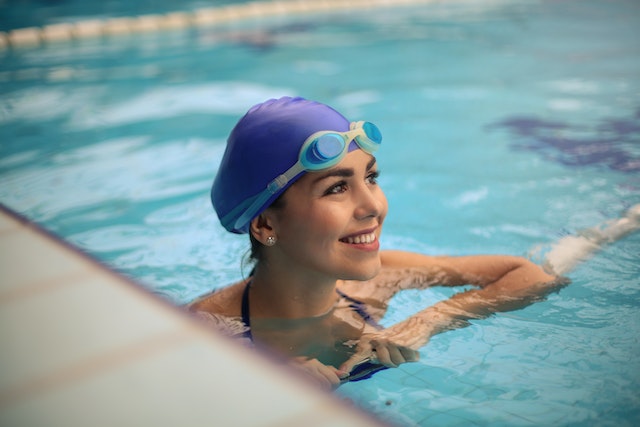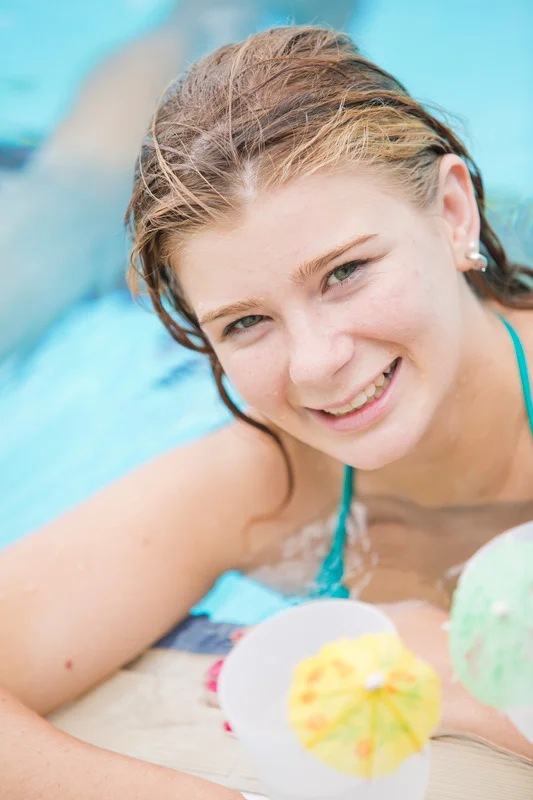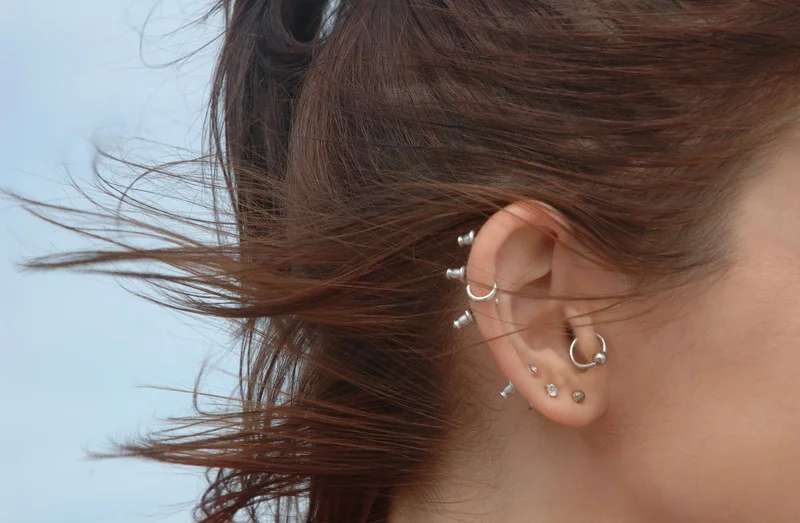How to Cover Ear Piercing for Swimming?
Getting your ears pierced is an exciting rite of passage, but determining when it’s safe to swim afterward can be tricky. So, how long should you wait before taking a dip? Let’s look at what you should and shouldn’t do to keep your piercing clean and infection-free.

What Happens if You Go Swimming with A New Piercing?
After getting an ear piercing, it’s best to stay out of the water for at least two months. Here’s why:
- Bacteria exposure: Pools, lakes, and oceans contain a variety of bacteria that can enter the open wound site and cause infection.
- Irritation: Chlorine and salt water can be extremely drying and irritating to a new piercing. This can cause inflammation, discomfort, and delayed healing.
- Jewelry displacement: Water currents may dislodge jewelry before the piercing is fully established. This disturbance in the healing route increases the chance of the piercing closing or migrating.
- Prolonged moisture: Wet piercings are more likely to swell and discharge if not cleaned and dried correctly. Remaining damp after swimming maintains the region hot, humid, and conducive to harmful germ growth.
How Long to Wait Before Swimming with a New Ear Piercing?
The recommended waiting period before submerging a new ear piercing generally falls between 4-12 weeks. Why such a broad range? Several things influence the duration.
- Piercing location: Tissue thickness is an important consideration. The healing time for an anti-tragus or cartilage piercing is longer than that of an earlobe. Wait at least 8 to 12 weeks for cartilage and 4-6 weeks for the earlobe.
- Jewelry style: A post earring stabilizes more quickly than a ring or hoop. Rings move about more, which slows the healing process. Wait longer if you’re wearing a hoop.
- Personal Health: Recovery rates vary depending on age, medicine, and pre-existing diseases. Younger, healthier people may recover more quickly than elderly people or those with chronic conditions.
- Aftercare diligence: How carefully you clean and care for your piercing on a regular basis determines how quickly it heals. Be consistent and patient to achieve the greatest results.
While the standard advice is no swimming for two months, assess your individual scenario and aims for the lower end of the 4–12 week range to be safe.

Swimming after Piercing in the Lake
Freshwater lakes pose a lower risk than saltwater or chlorine pools. But bacteria still thrive in natural environments. Before entering, make sure the piercings are completely closed and not bleeding at all; then, cover well and thoroughly rinse the holes with sterile saline. It’s advisable to wait at least four to six weeks before taking a plunge in a lake.
Swimming after Piercing in a Pool with Chlorine
Chlorine is particularly harsh on unhealed skin. Avoid pools for at least four weeks. The potent chemicals impede healing and promote infection. When piercings are 100% solid, covering them well is a must before entering.
Swimming after Piercing in the Ocean
Salt water entirely halts the healing process. Most professionals recommend waiting two full months before exposing piercings to oceans, bays, or beaches. If venturing in sooner, cover piercings airtight to protect from corrosive salt irritating tender holes.

How to Cover Your Piercings While Swimming?
Now, the million-dollar question: how can you enjoy the water without compromising the health of your piercing? Let’s look at several practical and stylish options for covering your ear piercings while swimming.
Waterproof Bandages
Adhesive bandages or strips designed to withstand water are the easiest option. Carefully place over each piercing site before swimming. Avoid bandages with sticky adhesive directly on the skin’s surface.
Look for breathable bandages made of hydrocolloid or silicone that still allow airflow.
Waterproof Tape
For a DIY approach, use a small piece of waterproof medical or athletic tape. Make sure the tape seals fully around the jewlery and ear contour without blocking needed air circulation.
Rotate the earring back slightly each time to avoid building up adhesive residue.
Ear Plugs
Foam or silicone ear plugs provide an excellent protective barrier when swimming. Their tapered shape inserts directly into the ear canal, covering piercings.
Look for ear plugs with contoured designs for comfort and security. Follow each use with thorough cleaning of piercings.

Plastic Disc Backings
If earrings have removable backings, swap out regular backs for waterproof plastic disc backings before swimming. These act like mini stoppers, keeping water out of piercings.
Carefully insert and remove disc backings to avoid irritation. Discard if they become difficult to insert smoothly.
Shower Caps
For temporary coverage, place a small shower cap or plastic baggie over the entire ear and secure hair away before swimming. This creates a DIY protective shell over piercings.
Use caution removing caps to avoid snagging tender new piercings.
How to Care for Your Piercing After Swimming?
Caring after a new piercing after any water activity is critical. Make sure to:
- Immediately remove any wet bandages, tape, or protective coverings after exiting the water.
- Rinse piercing sites and jewelry thoroughly with clean, drinkable water to remove any remaining pollutants.
- Gently gently dry the area with disposable paper towels or gauze. Avoid rubbing.
- Wash the piercing hole and jewelry as usual with saline spray or piercing cleaning. Rotate your jewelery while cleaning.
- After cleansing and drying, use a little moisturizer or antibacterial lotion to relieve inflammation and prevent infection overnight.
Healing Time for Ear Piercings
How long should you expect the full healing process to take for newly pierced ears? Here are general timeframes:
- Earlobes – 6-8 weeks
- Cartilage – 3-12 months
- Industrial – 6-12 months
- Daith/inner conch – 2-3 months
- Tragus – 6-9 months
- Helix – 3-6 months
- Rook – 4-6 months

Conclusion
With the right precautions protecting new piercings from water through coverage and cleansing, enjoying summer activities like swimming need not be sacrificed. Healing takes commitment but the rewards of sparkling accessories in your newly pierced ears all season long makes it worth the wait!
FAQs about Protecting New Piercings for Swimming
Use waterproof, flexible bandaids as piercing tape
These bandaids are super stretchy and water-resistant, so they should stick to your skin even during sweaty activities.
You can purchase a water-resistant bandage to cover your piercing during swimming activities. If you’re worried about a bandage falling off, opt for a swimming cap or waterproof band that covers the ears. Whatever you choose, make sure your ear piercing is completely covered so that water does not get inside.
You should avoid swimming for at least 24 hours after having a piercing, and ideally until it has healed properly. While it’s still healing, it’s important to keep the piercing dry as there’s a risk of infection.
If piercing covers are allowed, we recommend these two easy options:
Athletic tape.
Small adhesive bandages.
You should avoid swimming for at least 24 hours after having a piercing, and ideally until it has healed properly. While it’s still healing, it’s important to keep the piercing dry as there’s a risk of infection.
Another way to protect your ear piercings is by using a neoprene ear band. A neoprene ear band is similar to a headband like the one you wear before going under a dryer, but this one is waterproof. You can use a neoprene band to reinforce the swimming cap if you want to be safer.
Sources:
- Swimming After Piercing: Here Is What You Need To Know
- 3 Easy Ways to Cover and Protect Your Ear Piercing for Swimming
- How to cover ear piercing for swimming
- Can I swim after ears pierced?
- Pools and Piercings | Can You Go Into a Pool with a New Piercings?
- How to Cover Your Ear Piercing to Go Swimming
- Piercings and Water: Navigating the Seas of Swimming with a New Piercing
- Can I swim after getting a piercing?
- Piercings and Water: A Match Made in Heaven or a Recipe for Disaster?
- How do I protect my newly pierced ears from swimming?
- How Long Should You Wait to Swim After Piercing Your Ears?
- Can I go swimming after a piercing?
- How To Swimming After Ear Piercing
- How Long After Ear Piercing Before You Can Swim? Why & What Not To Do !
Learn More about Jewelry Tips:
- How to Tell If Gold is Real?
- How Are Rings Resized?
- How To Get A Ring Off Swollen Finger?
- DIY Solutions for Restoring Broken Necklaces
- Re-Piercing a Former Nose Piercing
- How to Get a Good Night’s Sleep with New Ear Piercings
- A Quick Guide to Inserting Hoop Earrings Smoothly
- Removing Flat Back Earrings Safely and Easily
- Why Does My New Piercing Itch? Causes and Relief
- The Complete Guide to Layering Necklaces Without Tangling
- Removing a Tragus Piercing – A Step-by-Step Guide
- Don’t Change Those New Piercings Too Soon!
- Why Does Ring Turn My Finger Green?
- How Many Piercings Can I Get at Once? Exploring the Art of Multiple Piercings
- When Can I Go Swimming After Piercing My Ears?
- Should You Wear a Rosary as a Necklace?
- 4 Most Popular Hypoallergenic Metals for Sensitive Skin in 2023
- How to Tie an Anklet: A Step-by-Step Guide
- Sleeping Comfortably With Earrings
- Spotting Fake vs Real Cartier Bracelets
- Safeguard Yourself with Meaningful Protection Bracelets
- Unlocking the Secrets: A Guide to Opening Hoop Earrings
- Identifying Genuine Chakra Healing Bracelets
- Feng Shui Guidelines for Powerful Bracelets
- Should You Wear a Copper Bracelet on Your Left or Right Wrist?
- Can You Shower With Pandora Bracelets?
